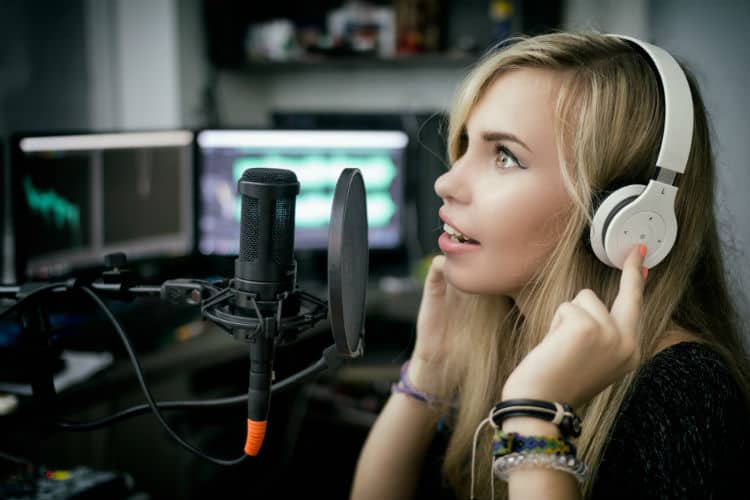Estimate reading time: 8:35
It can be incredibly frustrating to record voice overs that are lacking that professional sound. And re-recording voice overs that yield incoherent and indiscernible speech is enough to ruin a video. Furthermore, not knowing how to correctly setup your recording gear for best results can be irritating.
Don't be discouraged.
Recording voice overs at home can be a rewarding experience. Follow these easy steps and you'll be on your way to producing professional sounding voice overs in a matter of minutes.
How to Record Voice Overs?
Before recording voice overs, eliminate extraneous sounds such as noisy hard drives or air conditioning units. Next, apply fabric or dampening materials to the flat surfaces in your room. You can choose from a combination of acoustic absorbers and diffusers to reduce room reflections. Then, hit the record button and avoid bumping the mic stand. When you're done recording, review your voice overs with headphones and import your recording to your favorite audio editor for further processing.
How Sound Works
Sound travels in waves and sound pressure is defined as the local pressure deviation from the ambient atmospheric pressure. When it comes to recording, sound waves are difficult to control as they bounce off of walls and surfaces causing reverberations to hit the microphone capsule at various times. These variations are the cause for unintelligible speech. Untreated rooms that are excessively reverberant cause sound to flood the space making clear speech improbable.
There are two types of sound, direct and reflected. The direct sound consists of the path the sound takes from your mouth to the microphone capsule. Conversely, reflected sound or reflection as its commonly known, consists of the sound that bounces off the wall, milliseconds later in relation to the direct sound, and finds its way to the microphone. Clear speech is captured when a greater amount of direct signal (dry) reaches the targeted microphone while reducing the amount of reflections.
Here are a few easy to follow steps for improving your room or recording environment.
How to Soundproof Your Room
Room treatment isn’t as complicated as it sounds. You’re better off investing the time and energy into improving your recording environment as opposed to upgrading your mic and studio setup. No expensive microphone or gear upgrade will enhance the sound of your room as much as basic acoustic treatment.
There are two options for acoustically treating a room: absorption and diffusion.
Absorption
Absorption is the technique used to capture and reduce the intensity of echoes. Materials contributing to sound absorption are couches, carpets and sound proofing absorbers.
Diffusion
Diffusion is the technique that scatters reflected sound. For instance, placing diffusers throughout your recording space greatly reduced the audible presence of reflection in your recording. Diffusers scatter unwanted echoes away from your microphone.
Voice Over Recording Tips
Before hitting the record button make sure that your recording environment is as quiet as possible. For instance, disconnect noisy fans and humming air conditioners.Those sounds will creep into your recording limiting the amount of dynamic range you have to work with. Additionally, disconnect buzzing hard drives from USB or thunderbolt ports. If you’re surrounded by excessive extraneous noises, then select quieter time for recording. Many home-based voice over artists and content creators typically record at night when outside noises are at a bare minimum. Lastly, store noisy computer towers away from the microphone.
Be Aware of Microphone Placement and Polar Patterns When Recording Voice Overs

Be aware of your microphone’s polar pattern. Polar patterns determine the way your microphone responds to incoming signal. Typically, polar pattern diagrams are printed on the body of the mic. If not, then read the accompanying manual for specifications. Some microphone manufacturers like Blue let you toggle through various polar pattern settings. For instance, the Yeti Nano microphone lets users cycle between omnidirectional, bidirectional, cardioid and stereo mode. Some settings reduce the amount of extraneous noises that are picked up. By selecting a cardioid polar pattern for example, your microphone will accept sound pressure waves coming from the front and reject those coming from the sides and rear. Additionally, avoid using the omnidirectional polar patterns as this setting captures not only the direct signal, but also the reflections in near-equal amounts causing speech to be indiscernible. Omnidirectional polar patterns are ideal when in groups and only a single mic is available. As for microphones that sit on top of your desk like Blue’s Yeti Pro, care should be taken not to inadvertently bump any part of the desk causing undesired low end rumblings in the recording. In the event desk space is unavailable, Blue’s Radius 3 Custom Shockmount for Yeti and Yeti Pro USB Microphone not only reduces low end rumble but also provides multiple mic positioning for a clearer sound.
Here's more information on The Best Microphone for Podcast
Use Headphones When Recording Voice Overs
Use headphones to listen in on what is being picked up by the microphone. Prior to recording, listen closely to what is being heard. Is your smartphone’s vibration buzz audible? Are your hands bumping into your desk causing unwanted low end rumble? Does your chair squeak excessively with every twist and turn you make? Eliminating unnecessary sounds will get you closer to a professional voice over recording.
DIY Dampers
Reducing the amount of reflections in a room is achieved by using dampers. Firstly, use blankets to cover smooth surfaces that are located in your recording environment. Secondly, if covering your walls is not an option, then cover your head and microphone while you record. This setup is temporary but provides a quick and dirty solution. As a guideline, if you decide to place blankets on your walls, choose picture hanging strips as they are designed to support objects without leaving any marks on the walls. Your landlord will thank you for that.
If you’ve got an old couch or one seater that isn’t being used, add it to your recording studio. Depending on the material of the furniture, reflections will quickly find their way into the fabric therefore reducing the amount of room reverberations. Egg cartons are another solution however, the landscape for today’s soundproofing tools are plentiful. For example, a simple search on amazon for soundproofing yields stylish results that compliment room decors.
How to Use a Pop Filter and Windscreen When Recording Voice Overs
Voice overs are susceptible to plosives, sharp bursts of air caused by “p” “b” sounds. They are unflattering and cheapen the quality of a recording. Home and studio vocal artists apply a pop filter, a screen that is set between your lips and the microphone capsule and is designed to scatter bursts of air emitted from your mouth. The attached effortlessly to the microphone stand and are easily adjustable. Alternatively, a windscreen does the same thing only that its function is to reduce wind sounds from seeping into your outdoor recordings. Microphones such as the SM7B, a favorite among professional podcasters and voice over artists, come equipped with a windscreen that attaches to the microphone. In this instance, a pop filter isn’t necessary as the windscreen’s thicker material sufficiently eliminates unwanted plosives.
- Read more on eliminating breath and swallow sounds when recording your podcast
- Read more on understanding podcast equipment a step by step guide
- Read more on how to increase mic confidence when podcasting
Best Audio Effects For Voice Overs
Use an audio editor to enhance the audio characteristics of your recording. Import the audio into your favorite audio editor and begin applying audio effects such as a de-esser equalization, compression. Most audio editors (even free audio editors) come equipped with basic tools for processing audio. Below is a list of audio effects that are commonly applied to voice overs.

Noise Gate
A gate is a device that opens and closes as vocals exceed a given threshold. It eliminates distracting noises such as inhalations, exhalations and extraneous sounds caused by smacking lips and similar sound effects. Generally, a gate is set in place early on in the signal path before moving on to subsequent audio devices or plugins.
De-esser
As the name suggests, a de-esser reduces the amount of hiss in a recording. Higher frequencies (5k and up) cause a sharp hissing sound in most voice overs. This is especially apparent in inexperienced narrators. A de-esser variably tames harsher frequencies making the overall speech pleasing to the ear.

Equalization
A parametric equalizer helps to carve the overall sound of your recorded audio. For instance, most podcasters and voice over artists apply high pass filtering to reduce unwanted sub frequencies that make their way into a recording. Accidentally bumped the desk while recording? Use a high pass filter to reduce the jarring sound.
Compressor
The compressor is what gives your audio that much desired “radio” sound. Compressors were first introduced in the 1950’s as a way to reduce the dynamic range of a sound. Prior to the inception of digital audio, compressors were necessary to maintain the integrity of the analog consoles outputs. Today however, the technique is synonymous with professional broadcast audio giving it that coveted polished sound. When applied to a signal, compressors raise make the quieter segments of the audio louder while reducing the loudest portions. The end result is balanced audio amplitudes, something listeners have come to appreciate. Conversely, over-compression may cause fatigue and force your listeners to tune out of your content from ear fatigue. Mild compression goes a long way.
Normalizers
Normalizers bring the overall amplitude of a recording to a target level (the norm). Gain (volume) is applied throughout the entire recording so there is very little difference between the quietest and loudest sections. Lastly, audio normalization is handy when attempting to standardize the overall volume of a series of podcast episodes so they all stream at relatively similar volumes.
Conclusion
The guidelines presented in this article are designed to get you started on recording voice overs without having the shell out big bucks. As time progresses and your commitment to improving the overall sound of your podcast and voice overs grow, an investment in soundproofing equipment isn’t such a bad idea.



